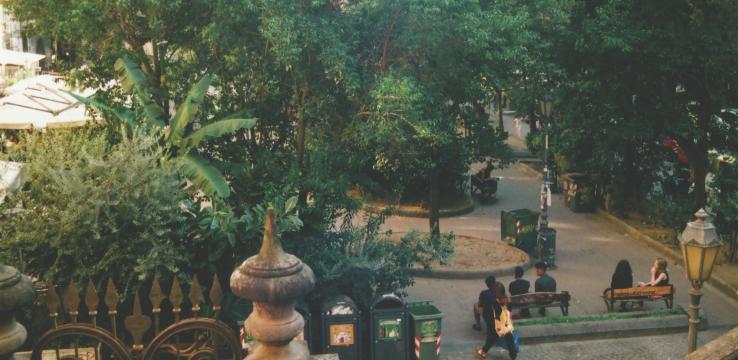
Monday September 26, 2016
Chiesa di Santa Maria Regina Coeli, 7 p.m. Naples is beautiful, lively, smelly, inspiring, confusing, cosmopolitan, proud, exciting and daunting. The streets are narrow and the buildings tall. Petrol fumes from scooters hang thick in the air. Classical facades dominate boulevards whilst tight apartments consume the alleys of the historical center, a UNESCO world heritage site. It is starting to get dark now and all the children that were playing football have been replaced by older Italian men and women congregating around the piazza.
A sense of scale in the Piazza del Gesu Nuovo
Via Santa Maria di Costantinopoli, 8:16 p.m. Jan Gehl’s 2010 Cities for People is my dinner date for the evening at a small outdoor table of a pizzeria on Via Santa Maria di Costantinopoli. Images of the young footballers laughing in the piazza run through my mind as I flick through this manual on how to read cities. Richard Rogers writes in the foreword: “Well designed neighborhoods inspire the people who live in them, whilst poorly designed cities brutalize their citizens.” Gehl explains that the more life and play is offered in the city, the more life expands. Using the case study of the 1989 earthquake in San Francisco, I consider the human condition for resilience and alternatively our underestimation of our ability to adapt and improve our urban form. We now realize the benefits of inviting public activity from a wealth of empirical evidence. When known benefits (health/crime/life satisfaction) are combined with the understanding that we seek the presence of others for safety and comfort, we can start to design truly inclusive spaces that inspire the kind of play I experienced outside Chiesa di Santa Maria Regina Coeli.
Others find different ways to play in the city
Sunday, September 27, 2016
Piazza Bellini, 12.59 p.m Locals are walking slowly. Beige paper wraps tasty looking lunches as people pace between bites. An accordion chimes in the distance. From Piazza Bellini you can hear the music school just around the corner, adding masterful opera to the already bustling hub of activity.
Killing time in the center of Piazza Bellini.
Reflections: Italy is sometimes referred to as ‘the land of human nature’ because of the tendency of Italians to fulfill each of life’s moments and exude a delight in living life. Naples is a city where emotions and sensations are fulfilled and externalized, and everything is communicated. This helps explain why Naples has traditionally had a predominance of informal spatial practices and a corresponding weak amount of formal regulation in its social life. Walking through Piazza Bellini past the music school you find yourself outside the Church of San Pietro a Majella in Piazza Luigi Miraglia, an unusually shaped space cut into three sections by bollards lining a cobbled road that runs through it’s middle. As I sat on a bench in the corner of the piazza, I noticed another group of young children playing football using the bollards as opposing goals. Nearby shopkeepers displaying porcelain statues didn’t bat an eyelid at the flying balls. Elderly women walked unconcerned through the children’s impromptu pitch and the players’ parents kept a watchful eye over the proceedings from a nearby second floor window. What would often be met in London (where I’m from) with concern or even anxiety, was here just another regular occurrence.
In Peter Rowe’s Civic Realism, he explores the richness of ‘play’ in the city: It “helps define and formalize relations among elements of public authority and civil society.” For these young people, play allows them to define their own space and engage in civil society in their own way, while experiencing joy and a sense of freedom. The transformation of the urban form into spaces of play is of course not exclusively an Italian phenomenon. If we take Rowe’s line of argument that spaces can offer “collective ownership,” then play in the city allows for an experience framed by collective joy.
Piazza Luigi Miraglia. A man sits on the steps of the Music School looking over the soon-to-be football pitch.
